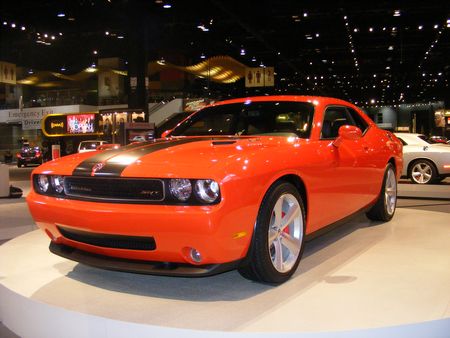




Dodge Challenger SRT8.................
If produced for actual sale, the Dodge Challenger concept would serve two very important roles: competing with another retro-styled muscle car, the Ford Mustang, and quieting all the classic-Charger enthusiasts who went ballistic when Dodge dared to use the Charger name on a four-door that was a Charger mostly in name.
The Challenger looks terrific. Unlike the Charger, the Challenger concept was styled to look like the classic 1970 version, and it does. The four headlights are small when compared to the current Dodge family style, and both the nose and tail are designed to make the car look as broad as possible. The car's track — the distance between the right and left wheels — is 1 to 2 inches wider than in the Charger and Chrysler 300, whose platform it shares.
Most important is the so-called Mopar fender, a beltline that rises dramatically just behind the door. That's one door, mind you, per side. The roof rises more steeply toward the rear than it did in the original, but this results in a backseat that's actually usable by adults. If the concept improves at all on the original, it's in the wheel treatment: They're large in diameter — 20 inches in front and 21 inches in back — and they're flush with the body sides rather than tucked way inboard.
The hood emulates the original's, complete with the power bulge, two air intakes and black racing stripes. Rather than black paint, the stripes are a total lack of paint that reveals the carbon fiber hood below it. The functional air intakes, fitted with butterfly valves, look great, but if they're anything like the original ones, they're counterproductive. Modern aerodynamics testing has proven that there's actually a vacuum above the hood this far back.
The concept uses the 6.1-liter Hemi V-8 that graces all the Chrysler, Dodge and Jeep SRT-series vehicles with 425 horsepower and 420 pounds-feet of torque. It drives the rear wheels through a six-speed-manual transmission controlled by a pistol-grip shifter. Dodge cites a zero-to-60 mph time of 4.5 seconds, a standing quarter-mile of 13 seconds and a top speed of 174 mph. A real product would likely use the Charger's five-speed automatic and the 5.7-liter Hemi V-8 with cylinder deactivation for better fuel economy. Would Dodge make a 3.5-liter V-6-powered version to compete with the Mustang V6? Perhaps.
The interior calls upon the classic for inspiration, but it's modern in the ways you'd like. In place of the classic bench seat are SRT-style buckets that are a better shape to keep you out of the passenger's lap. The center leather panels have horizontal ribs to evoke the look common in the '70s. The instrument panel is clever, with gauges set inside tubes that look like engine cylinders. The whole panel looks like a bank of a V-8 with its head removed. Unfortunately, like the other models that share this platform, the interior has plastic trim trying hard to look like aluminum — and failing. The upside is that this could mean the car is closer to becoming a real product than Dodge admits.
If they build it for sale, the Challenger would be like the original: a low-cost "pony car" that would compete with the Mustang in price, on the street and on the track.